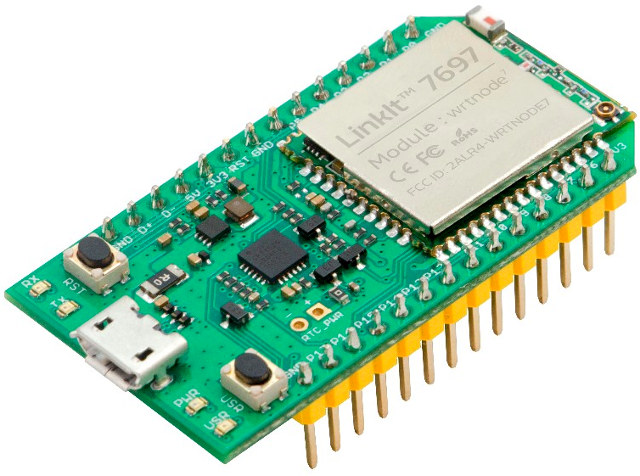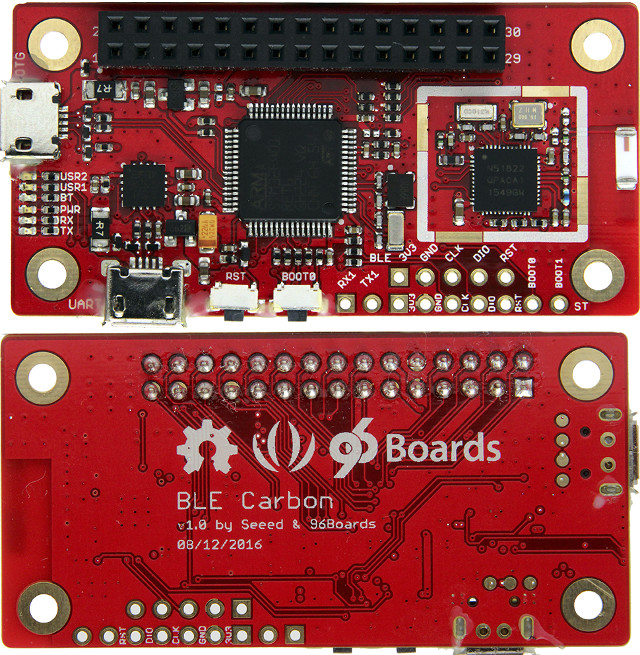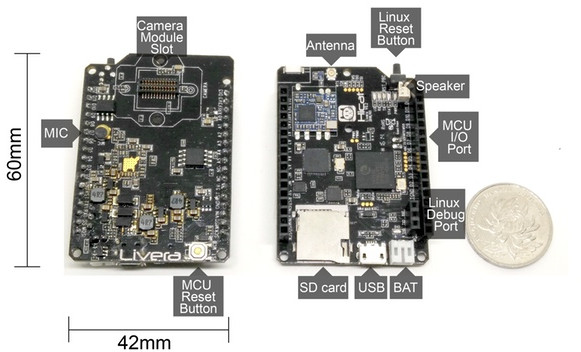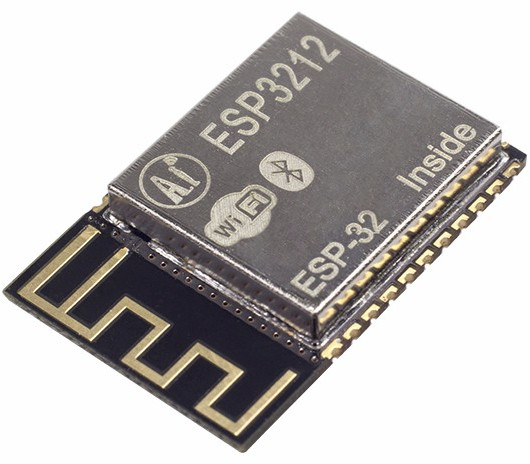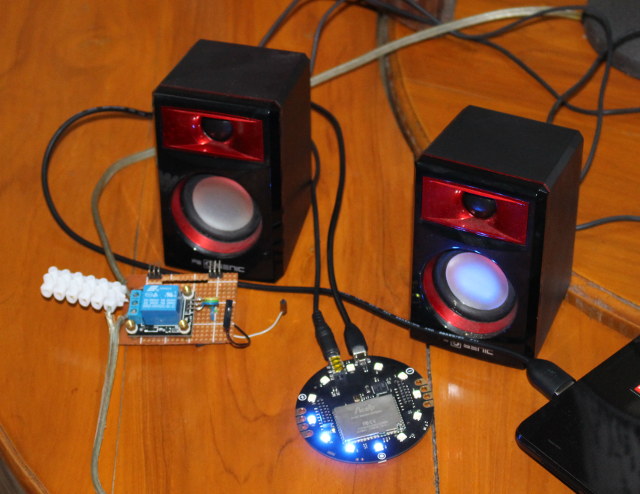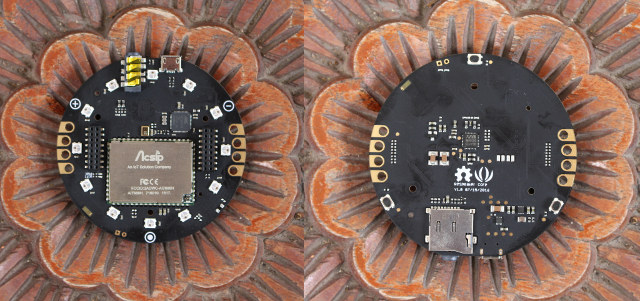Mediatek Labs has launched a new IoT development, which on the surface looks similar to LinkIt Smart 7688 board, but the internal design is quite different as the MIPS processor and Linux OS, have been replaced by Mediatek MT7697 ARM Cortex-M4 processor running FreeRTOS, and beside WiFi, also includes support for Bluetooth 4.2 LE. LinkIt 7697 board specifications: Wireless SoC – Mediatek MT7697 ARM Cortex M4F MCU @ 192 MHz with 352KB RAM, 4MB flash, 802.11 b/g/n WiFi, Bluetooth 4.2 LE and a PMU Expansion – 2x 14-pin header with 18x GPIO, 2x UART, 1x I2C, 1x SPI, 18x PWM, 4x EINT, 4x ADC (0 to 2.5V), 1x IrDA, 1x I2S Debugging – 1x SWD, CP2102 UART to USB chipset Misc – Reset and user buttons; power and user LEDs Power Supply – 5V via micro USB port Dimensions – 48 x 26 mm The board can be programmed with […]
Wio GPS is a $40 Grove & Arduino Compatible Bluetooth 3.0 + GSM/GPRS + GPS Tracker Board
After Wio Link and Wio Node boards, Seeed Studio has added a new board to their Wio (Wireless Input Output) family with Wio GPS board based on Microchip SAMD21 Cortex M0+ MCU for Arduino compatibility, and Mediatek MT2503 ARM7 processor for GPS, Bluetooth 3.0, and 2G (GPRS) connectivity. Wio GPS board specifications: MCU – Microchip ATSAMD21G18A-MU ARM Cortex M0+ MCU @ 48 MHz with 256KB flash, 32KB SRAM Wireless SoC – Mediatek MT2503 ARM7EJ-S processor @ 260 MHz Storage – micro SD slot (shared with nano SIM slot) Connectivity (built-in MT2503 in Quectel MC20 module) Bluetooth 2.1 + EDR, 3.0 with SPP Profile and HFP-AG Profile; u.FL connector for external antenna Quad band 2G GSM/GPRS with u.FL connector for external antenna and nano SIM card slot GNSS – GPS + BeiDou + QZSS with u.FL connector for external antenna Audio – Speaker footprint (+/-), 3.5mm AUX jack with mic and stereo audio […]
ESP8266, Mongoose OS & Grove Sensors – An Alternative Solution for Hackathons
CNXSoft: This is a guest post by Cesanta If you walked into any Hardware hackathon over the last year, you would see they are about innovation and bringing new ideas to this world and most of them are centered around the connected devices nowadays. However, just walk the floor, talk to the teams and you can quickly see an elephant in the room. The Hackathons are about connected devices, but with the ‘recommended’ and frequently sponsored hardware distributed to the teams such as Intel Galileo, Raspberry Pi, etc…. developers may struggle for a long time to even connect it to the cloud! Not to mention the innovation is usually hindered by a tedious environment setup which takes hours, things to learn about the specific hardware and how it can be programmed using low level languages. So many teams spent most of the time fighting with those issues and oftentimes still […]
BLE Carbon 96Boards IoT Edition Board Runs Zephyr OS
Linaro Connect Las Vegas 2016 is taking place right now, and the organization has some very interesting development, with a new focus on the Internet of Things thanks to the creation of LITE (Linaro IoT and Embedded) segment group that will work on “delivering end to end open source reference software for more secure connected products, ranging from sensors and connected controllers to smart devices and gateways, for the industrial and consumer markets”. The first LITE IoT Reference Platform release to be made in December 2016, but in the meantime, Linaro introduced 96Board IoT specifications, as well as the first compliant board with the launch of Carbon board (aka BLE Carbon) running Zephyr OS. Carbon 96Boards IoT Edition board specifications: MCU – STMicro STM32F401 ARM Cortex M4 microcontroller @ up to 84 MHz with 512kB Flash, 96kB ram Connectivity – Bluetooth 4.0 LE via Nordic Semi nRF51822 SoC + chip […]
HICAT.Livera Machine Vision Board and Robot Kit Feature HiSilicon Hi3518 SoC (Crowdfunding)
HiSilicon Hi3518 ARM9 processor is mostly being used in IP cameras, but Hicat startup decided to combined the camera processor with an Atmel MCU and a MT7601 WiFi module to create a wireless camera board to be used with OpenCV, and even provide a complete affordable robot kit with the board. Hicat.livera board specifications: Vision Core – Hisilicon Hi3518 ARM9 processor @ 440 MHz Storage – 16MB flash + micro SD card MCU – Atmel ATmega32U4 AVR micro-controller Connectivity – 802.11 b/g/n WiFi via Mediatek MT7601 module + u.FL antenna connector Camera interface with provided 140 deg. camera using Omnivision OV9712 720p (1280×720) sensor USB – 1x micro USB port for power and programming Audio – Built-in microphone, speaker header Sensors – MPU6050 accelerometer and gyro Expansion – 2x GPIO headers with GPIOs, I2C, SPI, serial, PWM, digital, analog and power signals. Misc – MCU reset and Linux reset buttons, […]
You Can Now Buy ESP3212 ESP32 WiFi + Bluetooth Module for $6.95
After the official launch of ESP32 processor for less than $3, it did not take long before ESP32 modules hit the market, and Seeed Studio has already listed ESP3212, one of the first modules based on Espressif ESP32 Bluetooth LE + WiFi SoC, for $6.95 with shipping scheduled to start on September 23, 2016. ESP3212 module specifications: SoC – Espressif ESP32 dual core Xtensa LX6 processor @ up to 240 MHz with 448 KB flash, 520 KB SRAM, 16 KB SRAM in RTC, WiFi and Bluetooth LE connectivity Storage – 4MB Winbond SPI flash Connectivity 802.11 b/g/n/e/i WiFi (HT40) up to 150 Mbps Bluetooth 4.2 BR/EDR and BLE 3 dBi PCB antenna Headers – 22x GPIOs (multiplexed with ADC, Touch, DAC, SPI, UART, CAN, ETH, IR, PWM, and I2S), 1x UART, Sense VP/Sense VN, EN pin. 3.3V and GND Power Supply – 3.0 – 3.6V Dimensions – 24 x 16 […]
Getting Started with ReSpeaker WiFi IoT Board’s Audio Capabilities, Voice Recognition and Synthesis
ReSpeaker is a development board combining an Atmel AVR MCU, a MediaTek MT7688 WiFi module running OpenWrt, a built-in microphone, an audio jack, and I/O headers to allow for voice control and output for IoT applications. That means you could make your own Amazon Echo like device with the board and add-ons, use it as a voice controlled home automation gateway and more. The board was launched on Kickstarter a few days ago, and already raised $100,000 from about 100 backers, but I’ve received an early sample, so I’ll provide some more information about the firmware, and shows how to use with some Python scripts leveraging Microsoft Bing Speech API. You’ll need a micro USB to USB cable to connect your to computer (Linux, Windows, Mac OS…), and a speaker to connect to the board. Linux (OpenWrt) boots in a few seconds, and once it’s done all RGB LED will […]
ReSpeaker WiFi IoT Board is Designed for Voice Interaction (Crowdfunding)
More and more devices are supporting voice interaction nowadays from your smartphone to devices like Amazon Echo, but so far, I had not seen development boards specifically designed for that purpose, and that’s exactly what Seeed Studio ReSpeaker board does by combining audio capabilities, WiFi connectivity, and I/O headers. ReSpeaker Core board specifications: WiFi Module – Acsip AI7688 Wi-Fi 802.11 b/g/n module based on Mediatek MT7688 MIPS SoC Storage – micro SD card slot USB – 1x micro USB port for programming and power Audio – 3.5mm AUX port, WM8960 audio codec, 2-pin header for external speakers Expansion – 2x 8-pin expansion headers for I2C, GPIO and USB 2.0 host connected to MT7688, built-in microphone. MCU – Atmel ATMega32U4 @ 16 MHz Misc – 12x RGB LEDs, 8x touch sensors, 3 push buttons Power Supply – 5V DC Dimensions – 70mm diameter Weight – 70 grams The board runs OpenWrt, […]


